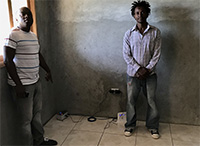Flagship Research Projects
{imageshow sl=23 sc=6 w=800 h=400 /}
HOPE - HOw Predictable are Earthquakes - ERC 2022
- Details
Earthquakes are spectacular natural disasters, as exemplified by the 2004 Sumatra and 2011 Tohoku-Oki earthquakes. Predicting earthquakes remains one of the biggest societal challenges in natural science. This research project will attempt answering the following question: How predictable are earthquakes? We propose a multidisciplinary approach articulated around three main axes: (i) the deterministic predictability of earthquakes in simple, homogeneous faults, studied by reproducing and understanding earthquake phenomena in the laboratory, (ii) the deterministic predictability of earthquakes in complex, heterogeneous faults, studied by laboratory experiments producing multiple earthquake cycles on faults with controlled heterogeneities and (iii) the statistical predictability of earthquakes, studied by forecasting the spatial distribution of experimental seismicity using machine learning.

OSMOSE - tOward a multi-stakeholder Socio-seisMological Observation network for Seismic risk rEduction in Haiti - ANR 2022
- Details
Over the past 50 years, earthquakes cost US$ 800 billions – mostly developed countries – and 1.3 million human lives – mostly in developing countries. While these figures show no sign of inflection, risk awareness continues to apply the classic approach where knowledge owned by scientists is translated “downward” to the public and decision-makers. Could a reverse, “bottom-up” approach where citizens collect and share information on earthquakes, be an alternate model?
LisAlps - Probing the 3D Alpine lithosphere by Full Waveform Inversion of the AlpArray teleseismic data - ANR 2021
- Details
![]() The Alpine chain has historically been one of the main natural laboratories to study orogenesis due to its outstanding outcrop conditions. Despite countless investigations, the deep structures imaged by geophysical methods and related tectonic processes remain controversial, due to the high complexity of the chain but also from the lack of high-resolution structural information at depth. To fill this gap, the European AlpArray consortium deployed 628 broadband stations, spaced less than 52 km apart, across the whole chain, and 30 ocean-bottom seismometers in the Ligurian basin, hence providing a unique opportunity for a step change in the 3D imaging of the Alpine lithosphere and asthenosphere. The LisAlps project proposes to apply Full Waveform Inversion (FWI) on the teleseismic data recorded during AlpArray to build:
The Alpine chain has historically been one of the main natural laboratories to study orogenesis due to its outstanding outcrop conditions. Despite countless investigations, the deep structures imaged by geophysical methods and related tectonic processes remain controversial, due to the high complexity of the chain but also from the lack of high-resolution structural information at depth. To fill this gap, the European AlpArray consortium deployed 628 broadband stations, spaced less than 52 km apart, across the whole chain, and 30 ocean-bottom seismometers in the Ligurian basin, hence providing a unique opportunity for a step change in the 3D imaging of the Alpine lithosphere and asthenosphere. The LisAlps project proposes to apply Full Waveform Inversion (FWI) on the teleseismic data recorded during AlpArray to build:
(1) a new reference high-resolution multi-parametric (1500x700 km) model of the alpine lithosphere and asthenosphere down to 700km depth from the entire network and a catalogue of ~300 teleseismic earthquakes (periods: 5s-20s);
(2) a high-resolution model of the lithosphere in the western Alps around the structurally-complex Ligurian knot.
- NILAFAR - The NILE & AFAR areas: hydrological change sensitivity and impact on past human adaptation since 20,000 years
- EARLI - detection of Early seismic signal using ARtificiaL Intelligence - ERC 2021
- WIND - Waveform Inversion of Node Data - Consortium 2020
- S5 - Synchronous Slow Slip & Seismic Swarm
- MARACAS - MARine terraces along the northern Andean Coast as a proxy for seismic hazard ASsessment - ANR JC 2018
- Com2SiCa - Understanding and Simulation of Human Behaviors in areas affected by disasters: from analysis to policy making
- FAULTS R GEMS - Properties of FAULTS, a key to Realistic Generic Earthquake Modeling and hazard Simulation
- INPOP and the Search of the Planet P9
- REMAKE - Seismic Risk in Ecuador: Mitigation, Anticipation and Knowledge of Earthquakes
- SISMED - Seismic Imaging inveStigation in MEDiterranean Sea for deep seismogenic faults
- E-POST - The Early POSTseismic Deformation
- HYDROSEIS - Role of fluids and fault HYDROmechanics on SEISmic rupture
- OBSIVA - Virtual Seismological Observatory for the Lesser Antilles Subduction
- TO-EOS - The Tohoku-Oki Earthquake from Earth to Oceans and Space
UMR Géoazur
Campus Azur du CNRS
250 rue Albert Einstein
- CS 10269 - F 06905 SOPHIA ANTIPOLIS Cedex
+33 (0)483 618 500




